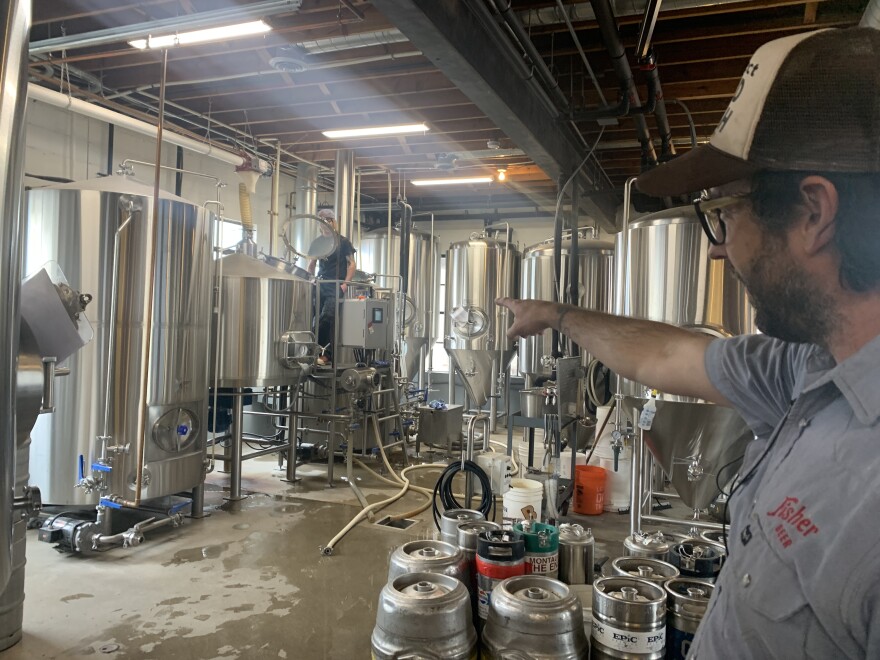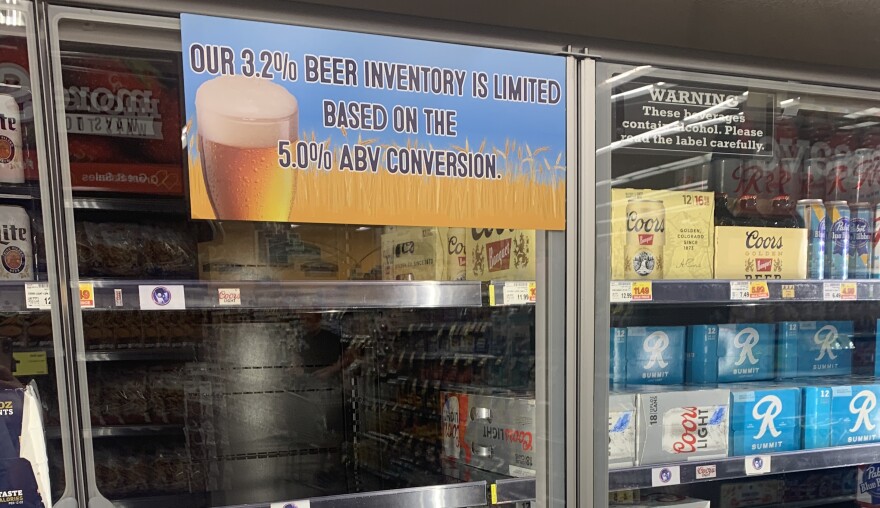Utah beer makers and drinkers alike are anxiously awaiting Nov. 1, when the limit on brews sold on tap and in grocery and convenience stores switches from 4% alcohol by volume (3.2% alcohol by weight) to 5% ABV.
Local brewers have had to work through several challenges in the months leading up to the shift, though.
At Fisher Brewing, co-owner and head brewer Colby Fraizer said brewing 5% ABV beer has made him less efficient — he brews less beer per batch while using more raw materials.

A recent batch of pale ale Frazier brewed at 5% ABV required 100 more pounds of malted barley than his 4% recipes. The grain is used to create a sugar water that eventually becomes the alcohol in a frosty glass of beer.
Frazier gestured at a round, stainless steel tank called a mash tun. The machine combines hot water with milled grain in order to break down starches into sugars. It’s also the source of his second problem.
“That tank has a capacity,” he said. “It’s only so big, and ours happens to be on the small side because it was designed to make sugar water at 4%.”
But Frazier is grateful for the flexibility to experiment with new recipes and make beer that he says will taste better.
“I make a lot of really hoppy 4% pale ales that are quite thin when it comes to body, so you really get punched in the face with hops. I hope that some of my pale ales will be a little more balanced” at the new limit, he said.
So for Frazier, who was one of the loudest supporters of raising the cap, those hurdles are well worth the shift to a higher ABV limit on beer, which he calls a “progressive change.”
“Whatever kind of complications we have in making that beer, we were more than willing to deal with and adjust as beer changes in the state of Utah,” he said.
'A Logistics Nightmare'
Like Fisher Brewing, the change has brought some headaches for Uinta Brewing, one of Utah’s largest beer makers, said President Jeremy Ragonese. For bigger brewers that distribute their own products, packaging has been one of the biggest challenges.
“It’s been a logistics nightmare for all of us to try and make sure that we run out of packaging or run out of certain types of beers at exactly the right moment so that we’re not overproducing and oversupplying when sales on those beers are going to slow down,” Ragonese said.
And sales, which normally get an autumn boost from football season and Halloween parties,
have slowed ahead of the ABV shift, he said.

He hopes that will change on Friday, when beer coolers in Utah stores — some of which have nearly emptied ahead of the switch — fill up again with new products.
While not every beer in Utah will go up to the new 5% limit, Uinta plans to increase the alcohol content in all of its widely-available recipes.
A seemingly small change can mean big things for a beer, Ragonese said.
“It’ll give it a little more flavor, a little more body,” he said. “Beers, for example, like (Uinta’s) Trader IPA will be a better beer. It’ll be a recipe that we are actually very excited about producing, just even by raising it to 5%.”
The brewery also plans to release a new product called “Hazy Nosh”, a 5% ABV version of its top-selling Hop Nosh IPA. In Utah, the 7.3% ABV Hop Nosh can only be purchased in state-run liquor stores, but the brew is Uinta’s most popular in other states where heavier beer is easier to access, Ragonese said.
Coming Around To 5%
When the Utah Legislature approved the new 5% ABV cap earlier this year, many local brewers were opposed to the increase, arguing that the shift was arbitrary and would help mega brewers more than local ones.
Nicole Dicou, executive director of the Utah Brewers Guild, says most of those brewers
that opposed the change have come around now.
“They see that consumers really want this change. They want more options,” Dicou said. “It’s good for craft beer overall if we can move the needle upward.”
Dicou said this is the first time the state has raised the ABV limit on beer since Prohibition. She wishes it would come without a 30-cent excise tax hike, which will bring the tax to $13.10 per barrel, to be paid annually by brewers based on their sales.
“It’s a big chunk of change for some of these smaller brewers — and the larger brewers that are trying to compete in Utah against a lot of barriers,” she said.
Despite the tax hike and the cost of extra ingredients, Colby Frazier at Fisher Brewing said he is “not currently considering any price increases.”
While some local brewers earlier this year spoke against the law that changed the limit, Frazier was at the Legislature advocating in favor of it. Now that’s it’s actually happening, he plans to switch some of Fisher’s taps over to new 5% ABV recipes on Halloween when the clock strikes midnight and ushers in Nov. 1.


